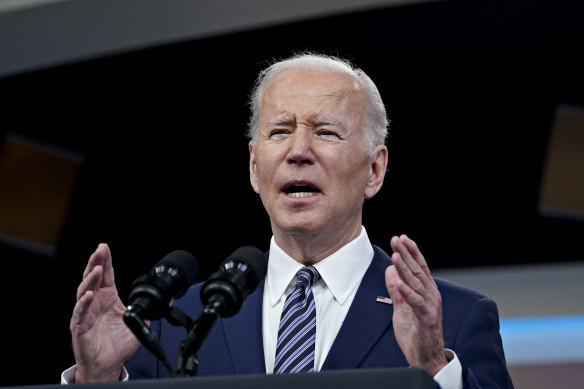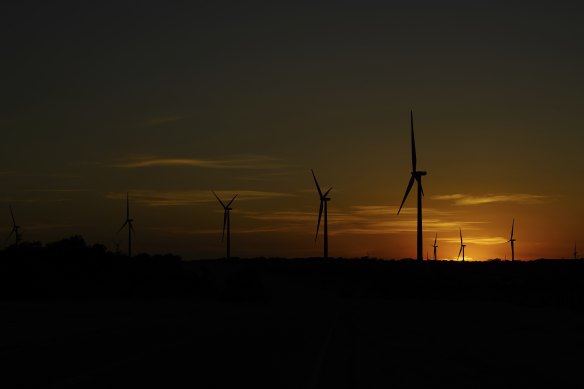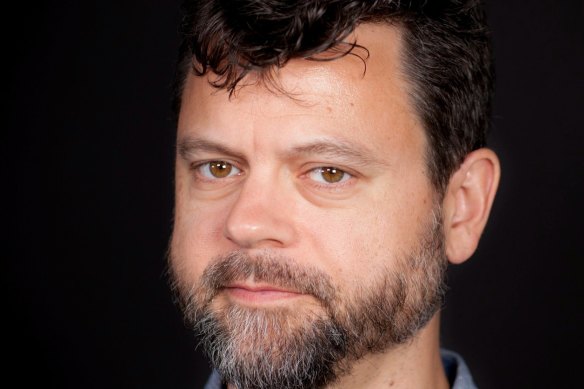How I learnt to stop worrying and love Biden’s IRA
Save articles for later
Add articles to your saved list and come back to them any time.
In the wonky world of energy policy the closest thing to a rock star might be David Roberts, a journalist-blogger and podcaster host who pulled guests like Barack Obama and Al Gore onto his show, Dr Volts.
This past week Roberts has been visiting Australia as a guest of the Electrical Trades Union, and hopes he can explain to Australian politicians and bureaucrats why this country urgently needs to pass legislation in response to the growing impact of the IRA.
US President Joe Biden’s Inflation Reduction Act is having a profound effect on the energy sector all over the world.Credit: Bloomberg
This is not an Irish paramilitary organisation but the Biden administration’s single most significant post-pandemic achievement, the Inflation Reduction Act. The impact of the IRA has proved to be far bigger than many predicted. It is now upending not just climate and energy policy in the United States and around the world, but industrial, economic and even foreign policy is being shaped by the great geysers of investment it has unleashed.
At first, Biden’s plan – called Build Back Better – was to entirely remake the American economy and social architecture in the wake of COVID-19. Parts were passed but much more was whittled away by a wall of Republican opposition and the mistrust of a handful of Democrats.
Biden’s team then set about rescuing the climate and energy sections of the broader plan, which they rebadged as the Inflation Recovery Act in view of conservative scepticism over climate action. Even then, most had given up on the bill passing due to the opposition of the coal-happy Democratic senator from West Virginia, Joe Manchin.
But it did, almost a year ago, and its impact has been profound. The IRA unleashed nearly $A800 billion in tax breaks and subsidies over a decade to boost clean energy infrastructure and encourage high-tech green manufacturing – think solar panels, turbines and batteries – to the US.
It is hard to exaggerate the impact of that sort of investment. According to a recent Goldman Sachs report companies have announced plans to build or expand 83 clean energy manufacturing facilities, including a $US5.5 billion ($8.45 billion) lithium-ion battery production complex in Arizona that has been described as North America’s “single largest investment ever” in a stand-alone battery factory.
Wind turbines near Del Rio, Texas. The Inflation Reduction Act has boosted the US transition to renewable energy, accelerated green domestic manufacturing, and made it more affordable for consumers to make climate-friendly purchases.Credit: AP
“It’s already clear that we’re seeing, as a result of the IRA, really a renaissance in American manufacturing,” American Council on Renewable Energy President and CEO Gregory Wetstone told Goldman Sachs. “I don’t think in my career I have ever seen a law have greater impact on economic development in this country.”
By some recent estimates IRA’s stimulus will spur up to $US3.3 trillion of investment.
But it has done more than that. Europe, which had grown used to seeing the US as climate laggards, was stunned by the passage of the IRA, which it sees not just as climate policy in disguise as inflation reduction, but as unfair subsidisation of US industry.
It is not an entirely unreasonable assertion. In April, the National Security Advisor Jake Sullivan placed the IRA at the heart of what he referred to as “the new Washington consensus”. The speech was a blunt refutation of unfettered globalisation and a declaration that the US government would have a hand in shaping the industries that built vital infrastructure and technology.
But it is more than a new industrial policy too. It is a broader rejection of the free trade policies that many Democrats believe hollowed out its middle class, fuelling not just misery in America’s industrial heartland, but distrust in government and a corresponding rise in middle-class radicalism.
The IRA also serves as a counter to China’s rise, as America determines to build supply lines not only of technology but essential minerals that run through its allies, particularly Australia with its wealth of critical minerals. Get used to hearing about “friendshoring” rather than on-shoring.
The policy has turbocharged a global race for green investment dollars, resources and brainpower needed to build the new green economies, which brings us back to David Roberts’ visit to Canberra.
Energy guru and podcaster David Roberts says “the more you invest in this stuff, the more growth you get, the more tax revenue you get, the better off you are.”
“We were pushing on open doors, people know how significant it is” says Roberts of his series of meetings with ministers and industry bodies. Indeed, during one of those meetings Climate and Energy Minister Chris Bowen said he believed that the IRA might one day be viewed as significant a moment in the fight against climate change as the signing of the Paris Agreement.
Says ETU national secretary Michael Wright: “People know that whatever our response is, it has got to be big. They just don’t really know what big is yet.”
It is not just access to minerals and resources that is concerning the sector. New power generation is being deployed at such a rate in the US that the old grid can’t keep up. The queue for access to interconnection has leapt by 40 per cent since the IRA passed.
A similar queue is forming in Australia, says Wright, where a further 10,000 kilometres of transmissions lines is needed. Wright had thought of bringing an apprentice lines worker with him to the meetings in Canberra this week to explain their work, but decided against it in the end.
“We only have 30 of them in the country, it seemed irresponsible to bring 10 per cent of the apprentice workforce to Canberra.”
The UTS Institute of Sustainable Futures last year found Australia needs 12,000 new workers in renewable energy by 2025. Over the longer term, overall electricity sector employment is projected to more than double from 37,000 in 2023 to 81,000 in 2049.
Where once we might have imported workers to cover the shortfall, now the world is in competition for the same pool of skilled labour. Australia must now work out how to train and then keep those workers it needs. That could mean going large in a response to the IRA.
Roberts dismisses those who fret over the size of the spending in the US.
“It’s maddening to me. I beat my head on the wall. The more you invest in this stuff, the more growth you get, the more tax revenue you get, the better off you are. If you ask me, personally, I think it was way too small. If you really want to transition your entire energy system, you need to be spending like at least two or three per cent of GDP,” he says.
“I mean, of all the worries I have, the government running out of money is not one of them.”
Get to the heart of what’s happening with climate change and the environment. Our fortnightly Environment newsletter brings you the news, the issues and the solutions. Sign up here.
Most Viewed in Business
From our partners
Source: Read Full Article




